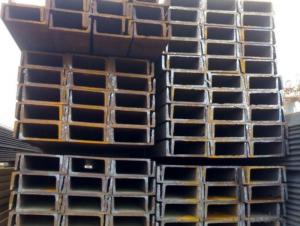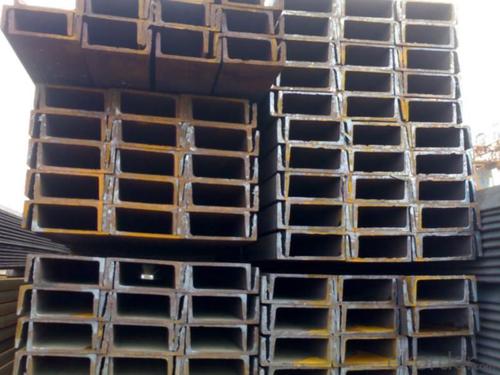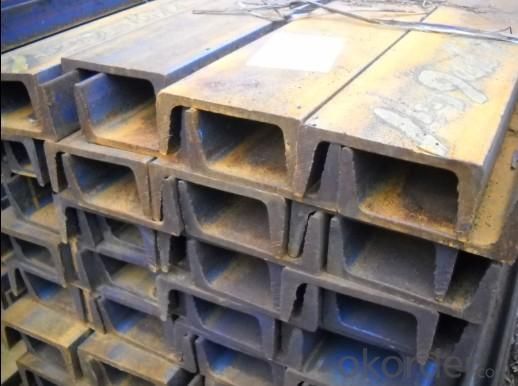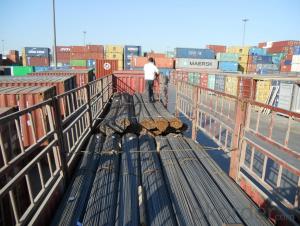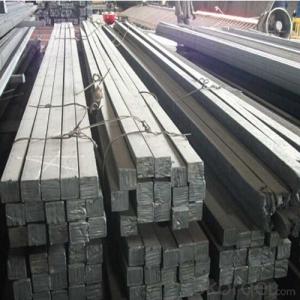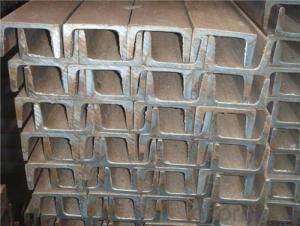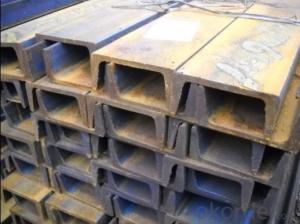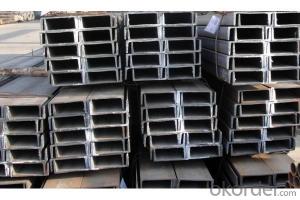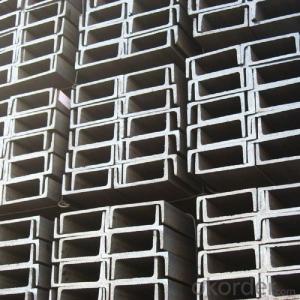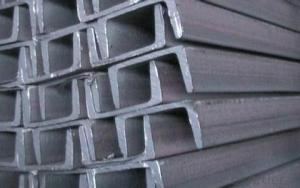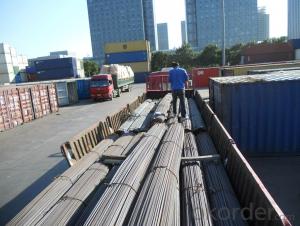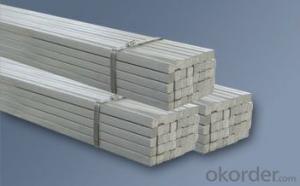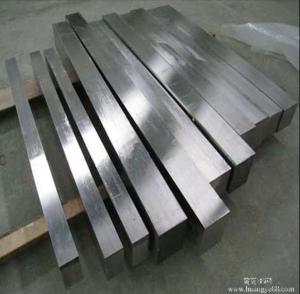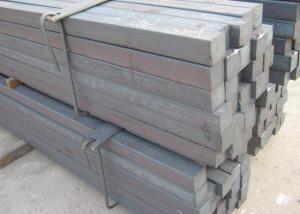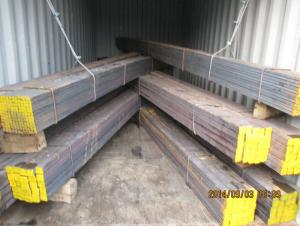100mm*50mm U channel steel for construction
- Loading Port:
- Tianjin
- Payment Terms:
- TT or LC
- Min Order Qty:
- 25 m.t.
- Supply Capability:
- 100000 m.t./month
OKorder Service Pledge
OKorder Financial Service
You Might Also Like
Product Description:
OKorder is offering 100mm*50mm U channel steel for construction at great prices with worldwide shipping. Our supplier is a world-class manufacturer of steel, with our products utilized the world over. OKorder annually supplies products to European, North American and Asian markets. We provide quotations within 24 hours of receiving an inquiry and guarantee competitive prices.
Product Applications:
100mm*50mm U channel steel are ideal for structural applications and are widely used in the construction of buildings and bridges, and the manufacturing, petrochemical, and transportation industries.
Product Advantages:
OKorder's U channel steel are durable, strong, and resist corrosion.
Main Product Features:
· Premium quality
· Prompt delivery & seaworthy packing (30 days after receiving deposit)
· Corrosion resistance
· Can be recycled and reused
· Mill test certification
· Professional Service
· Competitive pricing
Product Specifications:
Galvanized Channel Steel
1. Professional factory
2. Size: 50MM-400MM
3. Standard: GB,JIS,ASTM
4. Materials: Q235,SS400,A36..
A Hot Dip Galvanized U channel coating is relatively easier and cheaper to specify than an organic paint coating of equivalent corrosion protection performance. The British, European and International standard for Hot Dip Galvanizing is BS EN ISO 1461 which specifies a minimum coating thickness to be applied to steel in relation to the steels section thickness e.g. a steel fabrication with a section size thicker than 6 mm shall have a minimum galvanized coating thickness of 85 µm.
Further performance and design information for galvanizing can be found in BS EN ISO 14713-1 AND BS EN ISO 14713-2. The durability performance of a galvanized coating depends solely on the corrosion rate of the environment in which it is placed. Corrosion rates for different environments can be found in BS EN ISO 14713-1 where typical corrosion rates are given with a description of the environment in which the steel would be used.
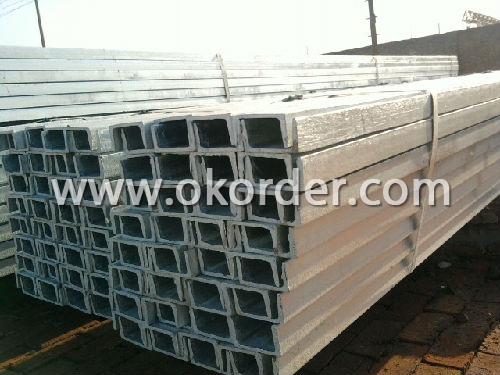
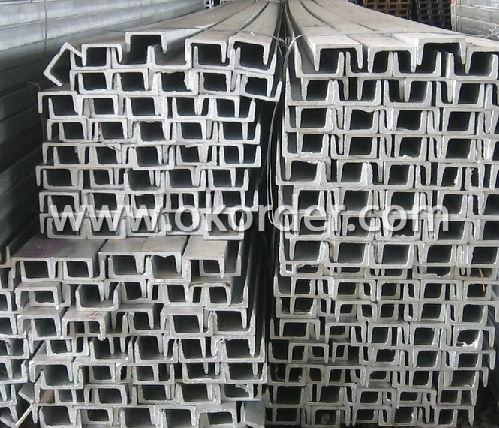
Galvanized Steel Channel | (mm) | (mm) | (mm) | (mm) |
|
50x25 | 50 | 25 | 3.0 | 6.00 | 2.37 |
75X40 | 75 | 40 | 3.8 | 7.00 | 5.30 |
75X40 | 75 | 40 | 4.0 | 7.00 | 5.60 |
75X40 | 75 | 40 | 4.5 | 7.00 | 5.85 |
75X40 | 75 | 40 | 5.0 | 7.00 | 6.92 |
|
|
|
|
|
|
100X50 | 100 | 50 | 3.8 | 6.00 | 7.30 |
100X50 | 100 | 50 | 4.2 | 6.00 | 8.03 |
100X50 | 100 | 50 | 4.5 | 7.50 | 8.97 |
100X50 | 100 | 50 | 5.0 | 7.50 | 9.36 |
|
|
|
|
|
|
125X65 | 125 | 65 | 5.2 | 6.80 | 11.66 |
125X65 | 125 | 65 | 5.3 | 6.80 | 12.17 |
125X65 | 125 | 65 | 5.5 | 8.00 | 12.91 |
125X65 | 125 | 65 | 6.0 | 8.00 | 13.40 |
|
|
|
|
|
|
150x75 | 150 | 75 | 5.5 | 7.30 | 14.66 |
150x75 | 150 | 75 | 5.7 | 10.00 | 16.71 |
150x75 | 150 | 75 | 6.0 | 10.00 | 17.90 |
150x75 | 150 | 75 | 6.5 | 10.00 | 18.60 |
150x75 | 150 | 75 | 6.5 | 10.00 | 24.00 |
|
|
|
|
|
|
200X80 | 200 | 80 | 7.5 | 11.00 | 24.60 |
2. The Mechanical property of Galvanized Steel Channel:
Grade | Yield Strength,N/mm² | Extension Strength N/mm² | |||
Thickness of Steel,mm | |||||
≦16 | >16-≦40 | >40-≦100 | >100 | ||
SS330 | ≧205 | ≧195 | ≧175 | ≧165 | 330-430 |
SS400 | ≧245 | ≧235 | ≧215 | ≧205 | 400-510 |
SS490 | ≧285 | ≧275 | ≧255 | ≧245 | 490-610 |
SS540 | ≧400 | ≧390 | - | - | ≧540 |
3. The chemical composition of Galvanized Steel Channel
Grade | Element(%) | |||
C | Mn | P | S | |
SS330 | -- | -- | ≦0.050 | ≦0.050 |
SS400 | ||||
SS490 | ||||
SS540 | ≦0.30 | ≦1.60 | ≦0.040 | ≦0.040 |
Usage of Galvanized Steel Channel:
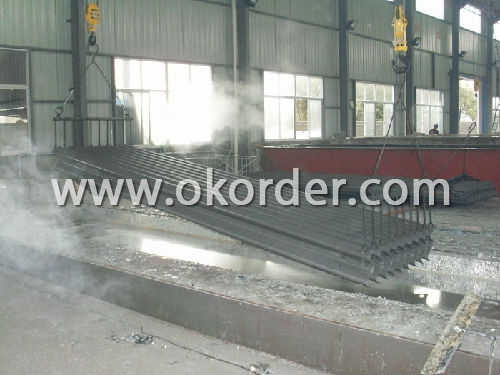
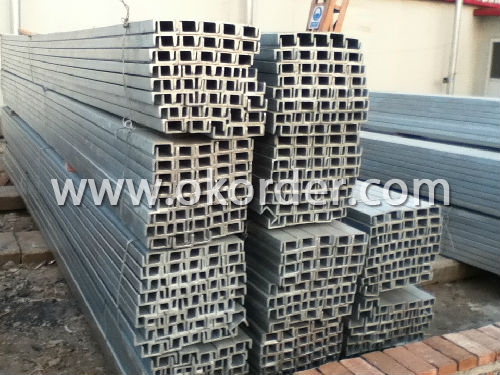
Applications: Galvanized for outdoor use or exposed evironments. Walkways, Ramps, Structural support
The process of hot-dip galvanizing results in a metallurgical bond between zinc and steel with a series of distinct iron-zinc alloys. The resulting coated steel can be used in much the same way as uncoated.
A typical hot-dip galvanizing line operates as follows:
Steel is cleaned using a caustic solution. This removes oil/grease, dirt, and paint.
The caustic cleaning solution is rinsed off.
The steel is pickled in an acidic solution to remove mill scale.
The pickling solution is rinsed off.
A flux, often zinc ammonium chloride is applied to the steel to inhibit oxidation of the cleaned surface upon exposure to air. The flux is allowed to dry on the steel and aids in the process of the liquid zinc wetting and adhering to the steel.
The steel is dipped into the molten zinc bath and held there until the temperature of the steel equilibrates with that of the bath.
The steel is cooled in a quench tank to reduce its temperature and inhibit undesirable reactions of the newly formed coating with the atmosphere
Package & Delivery of Galvanized Steel Channel:
1.The channel steel will be packed in bundle with steel wire at each end of every bundle and color marking in order to help the customer to recognize his goods more easily at sight.
2. And the channel steel could be loaded into 20ft or 40ft container, or by bulk cargo.If the weight of each bundle reaches more than 3.5 mt, the loading by break bulk cargo should be choosed.When the weight of each bundle reaches less than 3mt, the loading by container should be choosed.
3.As for the transportaion from mill to loading port, the truck will be usually used. And the maximum quantity for each truck is 40mt.
4.All in all, we could do in accordance with customer's request.
FAQ:
Q1: How do we guarantee the quality of our products?
A1: We have established an advanced quality management system which conducts strict quality tests at every step, from raw materials to the final product. At the same time, we provide extensive follow-up service assurances as required.
Q2: Can stainless steel rust?
A2: Stainless does not "rust" as you think of regular steel rusting with a red oxide on the surface that flakes off. If you see red rust it is probably due to some iron particles that have contaminated the surface of the stainless steel and it is these iron particles that are rusting. Look at the source of the rusting and see if you can remove it from the surface.
- Q: The working principle of steel punching machine
- Then tell you about the characteristics of mechanical punching machine1 mechanical punching machine uses lever principle, screw rod force, operation, saving labor, punching efficiency is high, punching once only 20-30 seconds;2 the main force head of the mechanical punching machine is made of super high strength alloy steel. It is light in weight and easy to carry;3 mechanical punching machine has the advantages of simple structure, convenient maintenance.
- Q: Can a steel square be used for checking the alignment of a planer table?
- Yes, a steel square can be used for checking the alignment of a planer table. A steel square is a versatile tool that is commonly used in woodworking and construction for measuring and checking angles, as well as testing for squareness and alignment. To check the alignment of a planer table, you can place the steel square against the edge of the table and make sure it is flush with the surface. By visually inspecting the square against the table, you can determine if the table is aligned properly or if it needs adjustment. Additionally, you can use the steel square to check the alignment of the fence or other components of the planer to ensure accuracy and precision in your woodworking projects.
- Q: What are some common uses for a steel square in box joint construction?
- A steel square is an essential tool in box joint construction and is used for a variety of purposes. Some common uses for a steel square in box joint construction include: 1. Layout and marking: A steel square is used to accurately mark and measure the dimensions of the box joint. It helps in setting up the appropriate size and spacing of the finger joints and ensures precision in the layout. 2. Checking for squareness: The steel square is utilized to check the squareness of the corners in box joint construction. This ensures that the joints are perfectly perpendicular and will result in a strong and sturdy box. 3. Aligning and guiding: When assembling the box joint, a steel square can be used to align and guide the pieces together. It helps to maintain the correct angle and ensures that the joints fit snugly, resulting in a tight and secure box. 4. Testing for flatness: The steel square can also be used to test the flatness of the joint surfaces. By placing the square against the surfaces, any gaps or irregularities can be detected and corrected before final assembly. 5. Cutting and sawing: A steel square can be used as a guide for cutting and sawing the box joint. It provides a straight edge for the saw or router, ensuring clean and accurate cuts along the joint lines. Overall, a steel square is an indispensable tool in box joint construction. It helps in layout, alignment, checking for squareness, and ensuring precision cuts, resulting in a well-fitted and strong box joint.
- Q: How do you use a steel square to lay out a tenon joint?
- To use a steel square to lay out a tenon joint, start by marking the width of the tenon on the end of the board using the square's blade. Then, use the square's tongue to mark the shoulder line by aligning it with the edge of the board. Next, mark the depth of the tenon by positioning the square's blade against the face of the board. Finally, connect the marks to outline the tenon and repeat the process on the corresponding mortise piece for a precise and accurate joint.
- Q: How do you use a steel square to determine the center of a circle?
- In order to determine the center of a circle using a steel square, you will require a compass, a pencil, and the steel square itself. Follow these steps: 1. Ensure that the steel square is stable and level by placing it on a flat surface or workbench. 2. Adjust the width of the compass to match the diameter of the circle you wish to find the center of. Secure the width by tightening the compass. 3. Position the compass on the steel square, with one leg resting against the inside edge of the square and the other leg extending beyond the edge. 4. Firmly hold the compass and rotate it along the inside edge of the steel square, drawing an arc on the surface below. 5. Repeat this process by rotating the compass along the outside edge of the steel square, drawing another arc that intersects the first one you drew. 6. The point where the two arcs intersect is an approximate center of the circle. 7. To verify the accuracy of the center point, slightly adjust the compass width and repeat the process. The new arcs should intersect at the same point as before, indicating that you have found the true center of the circle. Remember to exercise precision and caution when using a steel square to determine the center of a circle. Utilizing multiple measurements and varying compass widths can contribute to maintaining accuracy in your calculations.
- Q: Can a steel square be used for checking the levelness of a wall stud?
- No, a steel square is not suitable for checking the levelness of a wall stud. A steel square, also known as a framing square, is primarily used for measuring and marking angles in carpentry and woodworking tasks. It consists of a long arm and a shorter square arm at a 90-degree angle. To check the levelness of a wall stud, a level is the appropriate tool to use. A level is a straight, rectangular device with a bubble vial filled with liquid. When the bubble is centered between the lines in the vial, it indicates that the surface is level. Using a steel square for checking the levelness of a wall stud would not provide accurate results. It is best to use a level, which is specifically designed for this purpose and provides more precise measurements.
- Q: How do you use a steel square to lay out a diagonal line on a curved surface?
- To use a steel square to lay out a diagonal line on a curved surface, first, locate the desired starting and ending points of the diagonal line on the curved surface. Then, place the steel square on the curved surface, aligning one edge of the square with the starting point and the other edge with the ending point. Next, draw a line along the edge of the square to mark the diagonal line on the curved surface. Finally, use a flexible curve ruler or a flexible measuring tape to connect the marked points and create the diagonal line on the curved surface.
- Q: How do you use a steel square to measure and mark 151.875-degree angles?
- To use a steel square to measure and mark 151.875-degree angles, you would first align the 90-degree angle of the square with one side of the angle you want to measure. Then, you would pivot the square until the other side aligns with the 30-degree mark on the scale. This would give you a measurement of 120 degrees. Finally, you would add 31.875 degrees to the 120 degrees by using the 1/8-inch mark on the scale, and mark the angle accordingly.
- Q: How do you use a steel square to find the square footage of a room?
- To use a steel square to find the square footage of a room, you will need to follow a few simple steps. 1. Start by measuring the length and width of the room using the steel square. Place one edge of the square against one wall and extend it until it reaches the other wall, making sure it is parallel to the floor. Take note of the measurement on the square where it meets the opposite wall. Repeat this step for the other wall. 2. Next, measure the width of the room in the same manner. Place one edge of the square against the floor and extend it vertically until it reaches the ceiling or the top of the wall. Note the measurement on the square where it meets the ceiling or top of the wall. 3. Multiply the length and width measurements to calculate the square footage. For example, if the length measurement is 10 feet and the width measurement is 8 feet, the square footage would be 80 square feet (10 ft x 8 ft = 80 sq ft). 4. If the room has irregular shapes or angles, you can use the steel square to measure and calculate the areas separately. Break down the room into smaller sections with regular shapes, such as rectangles or squares, and calculate the square footage for each section. Finally, add up the square footages of all the sections to determine the total square footage of the room. Using a steel square can be a helpful tool for accurately measuring and calculating the square footage of a room. It ensures precise measurements and allows for easy calculations, especially when dealing with straight walls and regular shapes.
- Q: Can a steel square be used for checking the squareness of a wall?
- Yes, a steel square can be used for checking the squareness of a wall. Its right angles and straight edges can help determine if the wall is perfectly perpendicular and square.
Send your message to us
100mm*50mm U channel steel for construction
- Loading Port:
- Tianjin
- Payment Terms:
- TT or LC
- Min Order Qty:
- 25 m.t.
- Supply Capability:
- 100000 m.t./month
OKorder Service Pledge
OKorder Financial Service
Similar products
Hot products
Hot Searches
Related keywords
